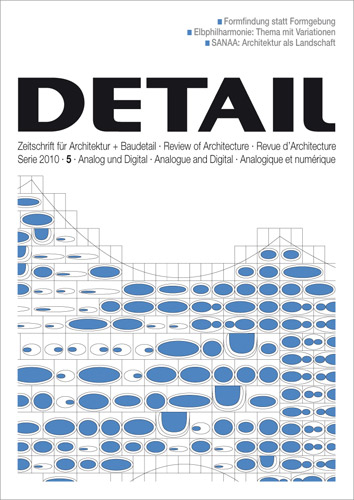Analogue and Digital (also available as English Edition 4/2010)

Today, a world without digital technologies is unimaginable, with the idea of somebody founding an institute for analogue studies almost as hard to entertain. That is exactly what Otl Aicher did in 1984. In his definitive work ‘Analogue and Digital’, published in 1991, he discusses what he sees as the danger of neglecting analogue practices in favour of an abstract concept and logical precision. While the editorial team addressed the topic of digital construction in DETAIL 12/2007, under the title ‘Digital Details’, for the current edition the title ‘Analogue and Digital’ seems more appropriate to us. Why?
The questioning of the balance between analogue and digital has become a key topic in any sensible approach to computers. What Aicher describes as “the school of making” is being increasingly combined with the most advanced digital equipment in schools. A primary task of new academic centres, with names such as ‘Institute for computer-based design’ or ‘digital design’, is to feed their digital 3D models with material parameters to ensure that only projects that can be realised with the materials and technology available are then developed further.
In his introductory article, Achim Menges draws a critical comparison between the double cambered wooden lattice framework of the Multihalle Mannheim, from 1975, and the wooden lattice roofing of the Centre Pompidou-Metz from Shigeru Ban that will be unveiled in May 2010.
In practice, just as in schools and colleges, there are also different approaches to digital and analogue. Cristiano Ceccato, co-founder of Gehry Technologies and associate at Zaha Hadid Architects, shows how the team led by Zaha Hadid and Patrik Schumacher are coming ever nearer to their goal of one continuous digital workflow, from design to actual construction. Herzog & de Meuron present the facade development of the Elbphilharmonie building and Matias del Campo, from SPAN, shows the development of his Austrian pavilion for the EXPO Shanghai 2010, which was executed completely digitally.
In contrast to such digital projects, Kazuyo Sejima and Ryue Nishizawa, from the Japanese architectural firm SANAA, developed their design for the Rolex Learning Center, in Lausanne, with analogue models. Structural planners Bollinger and Grohmann report on how precise plans have been developed from these studies, where even the individual reinforcing steel elements had to be programmed as 3D models. Lastly, we hear from the companies that act as consultants for the architectural offices. Not every architect has the expertise and the resources to deal with complex, parametric 3D models, but this could soon change with the coming generation of architects.

